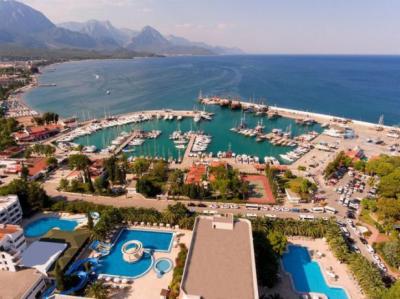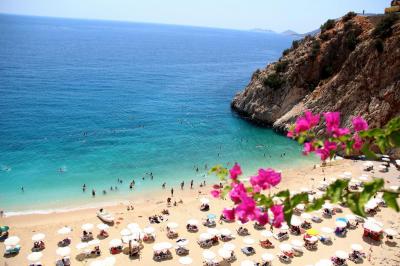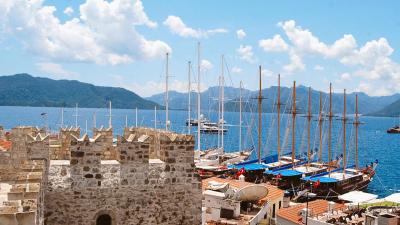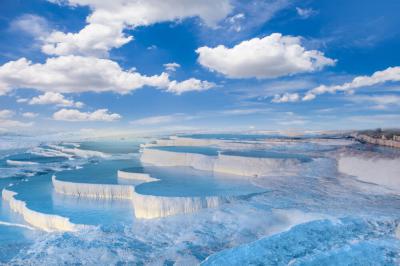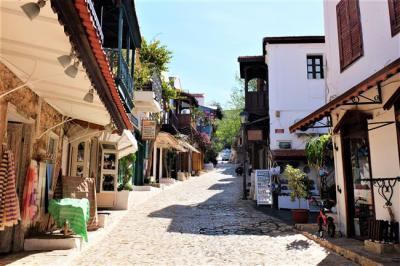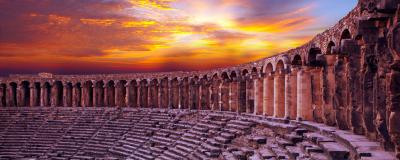When I say Pamukkale Travertines, I start with the view that makes people fall in love with themselves. In fact, the pure and naturalness of these travertines, which took me even more, and the thermals, which warm me even more, fascinated me as much as I said I could not stop by every year. Now all together, Pamukkale travertines, which have such natural beauty, are legendary. Let's see his story...
The Legendary Story of Pamukkale Travertines
A legend is hidden in every inch of our land. Some are like fairy tales, some are a sad love story. At work; The legend of the famous woodcutter, known as the "Legend of Pamukkale", lived in Denizli in our Anatolia. The story of the Lumberjack Beauty, which lived on the skirts of Denizli's Çökelez Mountain and has been told for centuries.
Many years ago, there was a poor woodcutter family living on the slopes of Çökelez Mountain in Denizli. The daughter of this family was so ugly that her face was spotty, she had boils and wounds all over her body, the girl was invisible to anyone because of her embarrassment, she couldn't look in the mirror, couldn't watch herself in still waters, she didn't want to see her in the people who came from around her. If the boy's mother came across her on the way, on the hill, on the mountain, they would turn their faces and change their way, even they would be so afraid that they would pray to this girl, "Oh poor girl, unholy girl, may Allah protect my son from you." Be a girl or come and endure this fate, it's not easy. The Woodcutter's Daughter had a pure disposition like still water and a heart of gold, a heart filled with compassion, a heart that always beats for others and knows only how to give. However, he still used to say to this ugliness, which his Lord deems worthy of him, but he still could not get used to it. After all, he was deeply hurt by the injustices that people did to him. All these experiences have worn out the beautiful woodcutter. She didn't care about her poverty, but she was obsessed with her ugliness.One morning, at dawn, he wrapped his writing around his head, climbed the Çökelez Mountain, looked around with sobbing tears on the slope of the mountain, to his beautiful homeland, where he spent his last life, to the people he loved but to whom he did not reciprocate, then raised his head to Sema.He said, "It is easier to die once today than to die a thousand times every day, Lord forgive me." He left himself from the steep slopes of the mountain to the void. How could he know that there are healing hot waters gushing from the depths where the beautiful woodcutter fell on the ridges under Çökelez?
That morning, Denizli Bey's son was out hunting and Çökelez was chasing partridges on their backs. As she hurried after her prey, she looked among the rocks, a girl's silver hair shining brightly in the hot puddles. The girl is pouring out because of the ecstatic waters. The son of the gentleman laid this beautiful girl in the shade of a tree as he embraced her. While he was wiping his scar, the woodcutter's daughter came to him. "Wow, aren't I dead," she started to cry. Beyoğlu tried to understand the situation and forced the girl to say, "I am an ugly woodcutter's girl with scars, bruises, boils and acne all over my face, why should I live after I can't talk to anyone," she said.
Denizli Bey's son was surprised at these conversations of the girl and said, "Are you ugly, woodcutter beauty, bend over and watch yourself in these waters, then ask, is the moon more beautiful, are you more beautiful?
The woodcutter's daughter stops and looks at the son of the denizli lord hesitantly, then he puts his hands to his face, looks at his arms and hands, there is no sign of his wounds, he quickly gets up and looks at the puddle, almost speechless. turned it into beautiful.That day, women of the world, who have heard and seen this, come to Pamukkale and throw themselves into the healing waters of Pamukkale. They bathe in those unique healing waters, and then they pray to the lumberjack girl who is beauties.
Indeed, the waters and muds of Pamukkale and Karahayıt are healing. Thousands of people from inside and outside the country come to Karahayıt and Pamukkale to enter these waters and apply mud on their body and take a mud bath.
HISTORY
This city, which is estimated to have been founded during the Phrygian period in the 2nd century BC, has also hosted many civilizations from generation to generation. It is known that it got its name from the Amazons Queen Hiera, who was the wife of Telephos, the legendary founder of Pergamon. This place, which has a strategically important location, has been one of the centers of the Christian faith. Even Hz. Philip, one of the twelve apostles of Jesus, was killed here. When the region passed under the auspices of the Byzantine Empire, it emerged as the Episcopal center. Also, according to a legend, a road (Hell's Gate) to Hades, the god of the underworld, is believed to be here.The city was home to more than a hundred thousand people at that time. Considering that this life took place two thousand years ago, it will not be difficult to guess that it was one of the mega cities of the period. The theater of a rare size with a capacity of ten thousand people also reveals the city's fondness for art. It is estimated that the Greek philosopher Epictetus was born in Hierapolis.
Thermal Water Is Believed to Bring Healing
One of the main reasons for the establishment of the city here may be because the thermal water coming out of the underground is thought to bring healing to people and to cure diseases. Moreover, the benefits of carbonate for human health have been scientifically proven today. The large bath at the entrance of the city is a structure designed for the passengers coming from outside. The fact that those coming out of the bath immediately go to the agora, that is, to the city square, reveals that the city was built in a planned way.The ancient pool, which was formed as a result of collapses, still continues to serve and heal today's people with its thermal water at 36 degrees Celsius. You can visit the Hierapolis Ancient City and Pamukkale Travertines with the Museum Card. However, you will have to pay an extra fee to enter the Ancient Pool. It is forbidden to go out with shoes on the travertines. You can take your swimsuits and bikinis with you to enter the travertine pools, large and small, the deepest of which reaches chest level.
Historical Places of Pamukkale
1. Hierapolis Ancient City

Hierapolis Ancient City, which was established on a hill 200 meters above Pamukkale, has a very important place among the ancient cities of Pamukkale and is included in the UNESCO World Heritage List. The word “Hiera” in the name of the city means “holy” in the Hellenic language. It is known that the city was founded by the King of Pergamon II.(second) Eumenes in the 2nd century BC. in 188 BC The city, which came under the rule of Pergamon with the Peace of Apomia made after the war between III.(third) Antiochos and Rome, was connected to the province of Asia in 133 BC. It is possible to see the influences of Pagan, Roman, Jewish and Christianity in the city. Frontinus Street, Agora, North Byzantine Gate, South Byzantine Gate, Gymnasium, Latrina, Ionic Column Headed House, Plutonium, Apollon Sanctuary, Cathedral, St. Philippus Martrium are among the important ruins of the city. B.C The Attalids dynasty, which was the ruler of the Pergamon Kingdom in the 2nd century, established these hot springs and benefited from the healing source thermal waters in the city in the pools. Large stone blocks were used in the construction of the baths. There are various open and closed areas connected to each other within the complex structure. A bath remaining from the complex structure is accepted as a museum with the same name today.
2.Cleopatra Pool
The Cleopatra Antique Pool emerged as a result of a pit formed after an earthquake in the 7th century AD. Magnificent columns entered this pit and thermal waters covered the pit, creating a natural pool. Rumor has it that Egyptian Queen Cleopatra, who learned that it was medicinal, came here to swim in the pool and find healing. That's where his name came from. The fact that the temperature of the pool is 36 degrees, which is ideal for people all year round, is proof that it is beneficial for human health.
3. Hierapolis Ancient Theater
Hierapolis Ancient Theatre, It is a point where time should be spared among the historical places of Pamukkale. This place is located in the Ancient City of Hierapolis and attracts attention with its impressive architecture. The theater, which could be completed after a period of 150 years, has been standing for 1800 years. It is estimated that the construction of the theater was completed in the 3rd century AD. The seats of the theater were built leaning against a hillside. There are 8 stairs in total between the seats. 95% of the materials used during the restoration of the theater are the materials of the theater, which means that the theater is largely faithful to its original.
4. Laodikeia Ancient City

The ancient city of Laodikeia, located 6 km north of Denizli, was in an important position in the past as it was at the crossroads of the main roads. Excavations carried out in Laodikeia, one of the most important ancient cities of the region, show that the settlement here was uninterrupted from the Chalcolithic Period to the 7th century BC. The city was also called by the names of Rhoas and Diopolis before. The city covers an area of about 5 square kilometers. It is thought that the foundation of the city dates back to the 3rd century BC. On this date, the commander II. It was founded by Seleucus Antiochus for his wife Laodice and its name comes from here. The region later became part of the Roman Empire in 130 BC. The theater and the monumental fountain are among the most important historical spots to be seen in the city. The city, which was seriously damaged by a great earthquake in 494 AD, was not able to return to its old flamboyant days afterwards. Excavations in the city still continue today.
MUSEUMS
1. Hierapolis Archaeological Museum
The ancient city of Hierapolis, dated to 190 BC, is among the important ancient sites of Pamukkale. The city, which was largely destroyed after the earthquake, was rebuilt by the Romans. Today, the bath, which belongs to this impressive city of history, welcomes its visitors as a museum. The museum was opened to visitors on February 1, 1984. The founding story of the museum dates back to the 1970s. Visitors to the museum have the opportunity to see not only the artifacts obtained from the excavations in the Ancient City of Hierapolis, but also the artifacts from ancient regions such as Laodikeia, Colossai, Tripolis and Attuda. Artifacts belonging to Beycesultan Mound, one of the important cities of the Bronze Age, are also exhibited in this museum. There are three main indoor areas in the museum, namely the sculptures and sarcophagi hall, the small finds hall and the theater finds hall.





